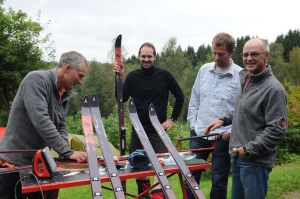Smooth skiing in cold conditions
The last thing we did before our gear was loaded onto the plane destined for Union Glacier was to scrape eight pairs of skis. For those who have not been initiated into the fine art of waxing skis, scraping involves removing glide wax from the leading and tail parts of the skis. Our skis have been subjected to intensive treatment in preparation for when we put them on in Hvalbukta, and they have been waxed as if Petter Northug were about start an olympic 50 km race in cold conditions.
 Vegard ensuring we'll glide across the snow like olympic skiers. Photo: Erik Edland Vegard ensuring we'll glide across the snow like olympic skiers. Photo: Erik Edland
The underside of the ski was first given a fine-grained structure that offers less friction than an entirely flat surface. After that, the gliding zone was saturated with cold glide wax CH4 and CH6, which was scraped and brushed ten times before we left Norway. The kick zone was roughened up with coarse sandpaper a thin layer of ice klister and base wax has been ironed in. On top of that went five thick layers of Polar wax. Roald Amundsen writes about new snow at the start of his expedition. If we meet similar conditions we may be able to use waxed skis for the first few dozen kilometres. Waxed skis offer lower friction than if we attach skins (strips of synthetic fur that prevent the skis from gliding backwards). Once the wax has been worn down, we will have to use skins anyway. We have skins of three different lengths. We also have a small lump of CH4 to put on the glide zone on days when we encounter the snow conditions Amundsen called “fish glue”.
Our skis are from Åsnes, the model named Roald Amundsen, and are 205 and 210 cm long. Roald Amundsen’s skis “of finest hickory” were eight feet long (244 cm). The extra length was meant to improve the skis’ capacity to carry weight over the dreaded crevasses – which we also expect to be the greatest peril we meet on the expedition.
On our feet we have Alfa’s latest model North Pole with BC (back country) bindings and extra inner boots of felted wool, whereas Amundsen had specially made “moccasins” with a rigid sole and uppers made of leather, cloth and sealskin. The bindings were Huitfeldt’s model with iron clips, which revolutionised the sport of skiing when it came onto the scene in 1894. Amundsen also used Høier Ellefsen’s heel-stabilising strap, which had just been introduced.
Our sleds from Fjellpulken in Lillehammer represent a small technological revolution for use on expeditions and showed great promise during our tests back home. They glide along on Åsnes’ lightest ski model, the 190 cm long Holmenkollen ski, rather than on the sled’s broad fibreglass hull as sleds have usually been used on modern-day expeditions. A thoroughly unscientific experiment involving a fish-weighing scale attached to the traces showed a 30% reduction in the amount of pulling force required.
|